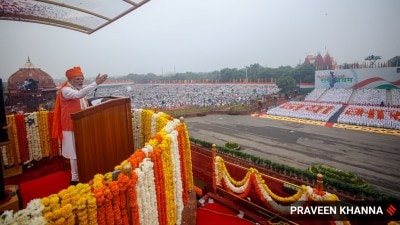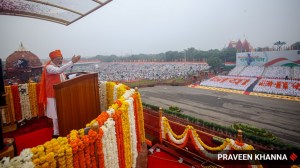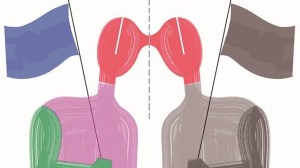Stay updated with the latest - Click here to follow us on Instagram
Hardlook: Regularisation of Residential Encroachments; Putting house in order
Around 70,000 families will be benefited with Gujarat government’s decision to regularise residential encroachments on government land.
 (Clockwise from top) Chandaben Parmar of Maganji ni chali in Ranip, Ahmedabad, who is helping her fellow slum-dwellers get sanad; Javed Raja and Gopal Kateshiya
(Clockwise from top) Chandaben Parmar of Maganji ni chali in Ranip, Ahmedabad, who is helping her fellow slum-dwellers get sanad; Javed Raja and Gopal Kateshiya
Earlier this month, the state government gave out title deeds to around 600 families after ‘The Gujarat Validation of Possession of certain Lands of Excess Vacant Land Vested in the State Government (under the Urban Land Ceiling and Regulation Act, 1976) Ordinance 2016’ was cleared.
The ordinance was aimed at regularising all residential properties built on government land acquired under Urban Land Ceiling and Regulation Act 1976. Seen as an exercise that will reap huge political dividends, it is expected to benefit around 70,000 families in the five major cities of Ahmedabad, Vadodara, Surat, Rajkot and Jamnagar. The total land covering such residential areas is almost 33.88 lakh square metres.
The government has so far received 11,000 applications, the last date being April 30 (it was extended after the March 15 deadline expired).
In order to apply, the residents have to produce any two of the following to corroborate their identity and place of domicile – ration card, aadhaar card, passport, driving licence, EPIC, electricity, property tax or water bills, along with a copy of notices given under Sections 61 (eviction) and 202 (vacating the land) of Gujarat Land Revenue Code, 1879.
After receiving the application and fee (Rs 10,000 for 100sqm plots and Rs 25,000 for land bigger than that), the mamlatdar issues a notice inviting objections from any person within a period of one month from the date of submission of application. In case of objections, the mamlatdar hears all claims. After everything is cleared, the application is approved and the applicant gets a notice to pay the remaining amount, calculated as per jantri (ready reckoner for market rates of land set by the government).
The payment needs to be made within a month of receiving the notice, failing which the application will be rejected.
After receiving the payment, the mamlatdar passes an order of validation of occupancy and allotment of excess vacant land.
The occupants, in whose favour the order is passed under sub-section 4 of Section 7 or his heirs, however, can’t transfer such land before 15 years.
If the stakeholders fail to apply for regularising their plots, the mamlatdar has the power to treat it as an encroachment and take possession of the residential structure.
Here’s a look at some of the applicants and beneficiaries in four cities:
The lucky No.1
Ahmedabad
Survey number 111/1/1, Rushabh Flats, Acher, — it is indeed the lucky first one to get a sanad (title deed) from Chief Minister Vijay Rupani during a function at Tagore Hall on March 11, thus legalising the apartment, built on ‘excess vacant land’ as identified by the revenue department.
Twelve of the 16 two-BHK flat owners of Rushabh Flats, built on a 401.34 sqm plot on main BRTS route near Acher stop, became the first legal holders of the structure, which was till date considered encroached on. Most of them belong to low income groups.
Rest four had decided to sue the owner and builder of the society. So they were left out. Society chairman Vimal Patel said now even they had applied.
“We believe our survey number to be a very lucky one. We are the first ones to have got the orders,” said Patel. The society residents had learnt about the status of their land in 2004. “So when this scheme was announced last December, we grabbed the opportunity and visited the mamlatdar office in Sabarmati the very day we heard about it. The office was still working out the rules, so we were asked to visit after three-four days,” said Patel who runs a travel agency.
“When the government is itself approaching us, then why should we back out? Even the government officials at the mamlatdar office were very supportive, available round the clock for any query,” said Jitendra Rathod, the society secretary.
Each household had to pay Rs 53,113 (the amount calculated on jantri rates) and
Rs 10,000 as application fee.
The society was built in 1999 on the plot owned by Hakmaji Andaji Chauhan. Same year when the Urban Land (Ceiling and Regulation) Repeal Act, 1999, came into effect, this plot was identified as ‘excess land’ by the state government. Till 2004, all revenue documents were in the name of ‘Rushabh Sabarmati Association’. However, the state took the ownership after a survey in 2004.
Ahmedabad’s collector office has received 6,441 forms till March 18 and so far 55 sanads have been given by the revenue department.
Those willing to regularise their plots will have to pay Rs 10,000 as an application fee for a 100 square metre land and Rs 25,000 for areas bigger than that. This will be adjusted in the final amount calculated as per the jantri rates.
So far, 32,913 households have been identified on 557 ‘excess vacant’ plots of a total of 15,30,637 square metre area in Ahmedabad alone. But, only 19 per cent have been surveyed.
As many as 23 such plots have been identified in Sabarmati area alone, on which a dozen slums exist. Though the scheme seems lucrative, for the humble slum dwellers, the application fee is a major hurdle. “For us, paper work is not the only problem. It is the initial sum of Rs 10,000 as the application fee,” says Chandaben Parmar (39), resident of Maganji ni chali in Ranip under Ahmedabad Municipal Corporation’s New West Zone.
The slum has around 400 houses and is mainly populated with people from Thakore community (Other Backward Class). Nearly 100 have been identified and served notices under the state government’s Urban Land (Ceiling and Regulation) Repeal Act, 1999. Barring around 15 kutcha houses, majority of the remaining one-room dwellings are brick-walled with corrugated tin roofs. Many have to borrowed money on interest or from their relatives in order to apply.
Only 17 inhabitants of the chaali have applied and none have got a sanad yet. Majority of the residents here are uneducated and are either daily wage labourers or rickshaw drivers, says Chandaben, holding a sheaf of application forms as she returned from the nearest bank.
A native of Mehsana but settled in Ahmedabad since decades now, Chandaben is considered a ‘social worker’ by the residents. Married to Ganeshbhai, an auto rickshaw driver for 20 years, she gave up her small saree business, which she ran from her one-room house, some six months back and has been working full time to help the residents get sanad. She also got her parents’ application filled and submitted for their Motera house that also falls under ULC.
The revenue department has also identified point persons like Chandaben for achieving their target of sanads.
“We have identified residents like Chandeben from different areas with whom we can communicate, make them understand and convince them about this scheme,” said Mamtaben Sojitra, additional resident deputy collector. RITU SHARMA
Relief from fear of demolition
Vadodara
Inside his 51 sq m home at Swami Suryanarayan Nagar in Vadodara’s Manjalpur area, Gulabrao Meghraj Patil was busy supervising his flour mill running from a 6.5 sq m room — it’s noise is the only sound one can hear in the quiet society on a scorching afternoon. Gulabrao, 57, is one of the 77 beneficiaries in Vadodara of the state government’s policy to regularise homes built on encroached lands under the ULC Act. His father Meghraj Tanaji Patil, 80, received the land deed (called sanad) from the District Collectorate on March 11, making him a legal owner of two of his homes located in the same row.
Gulabrao said, “While I live with my father and my family — wife and son Durgesh — in this house, just four homes away is another of my father’s homes, where two of my brothers Bharat and Dilip live with their families. Till we received this deed, we were under a lot of stress as the VMC had declared a Town Planning scheme in our area two years ago, which would have meant demolition.”
A former mill worker Gulabrao’s family paid approximately Rs 92,000 for each of their homes to secure the deed. “We had purchased the house for Rs 50000 from a farmer who sold part of his land in 1985. At that time, it was just a tin house. We built the pucca house over a period of time. We feel very blessed that this law amendment came just in time for us to regularise our homes,” said Gulabrao, adding that arranging the money was not a problem. “I was forced out of work in 1999 when the mills shut down, but I have been running the flour mill since then. My brothers also work in private firms and my son is now working at a private company after completing BCA (Bachelor of Computer Applications). Arranging the money was not a problem.”
The ULC certificate, however, prohibits the use of the premise for any other purpose except residential. Gulabrao said, “The flour mill is my source of living today as I cannot sit idle. People around me are supportive and I do not think it should be a problem running this mill from here. It is my home-based business and not a commercial establishment.”
Just three homes away, lives Vasant Mahadik, who has served at Bombay Engineering Group, a regiment of Corps of Engineers in the Army. Mahadik took voluntary retirement in 1988 and since has worked in private banks as special security officer and currently works as a security staffer in ONGC. Mahadik is also leading the association of residents of the settlement to ensure that every home is regularised in the area. “We have made 349 applications in all under the ULC Act. Out of these, 22 have been approved and received their sanad on March 11. We are hopeful that the others will also receive their sanads in batches,” Mahadik said.
Mahadik’s house is two storey, each floor measuring about 37 sq m. Mahadik received joint sanad with his wife Ashwini after paying Rs 40,700 as per the prevailing jantri rates for the area to regularise his home. Originally purchased for Rs 40,000 in 1980, Mahadik says he constructed the home over a period of time. “I have two sons. One son is away and the other lives with his wife with us. So far, we were afraid that the home could be demolished. But, we are very grateful to the government, regardless of which political party is in power, that it took this necessary step to stop people from getting homeless?” he said.
Mahadik said the residents were first called to the town hall in January where the process was explained and officials
“personally helped out” fill and process applications. “We must mention that they have extended complete support in completing the process for most families, even visiting us at odd hours to help in the process of documentation after the measurements were taken,” he said.
He was confident that all of the 349 will be completed soon. “There are a few cases where the families are not able to pay the premium calculated as per jantri rates. Although their applications have been approved, until they make the payment, they will not receive the sanad for regularisation.”
ADITI RAJA
Property prices set to rise
Rajkot
Officials in Rajkot said unauthorised houses have been built on around 2.45 lakh square metre of land vested in government and land ownership rights were given to 22 applicants on March 10. Out these 22 applicants, 12 were from the jurisdiction of mamlatdar (South) — majority of them, nine, were residents of New Meghani Nagar society on Sahkar Main Road. There was one applicant each from Shreenathji Society and Somnath Society on 150 feet Ring Road where property prices are amongst the highest in the city. The remaining applicants were from the jurisdiction of mamlatdar (East) and residing at Triveni Society on Sant Kabir Raod, Bhagvati Society on Doodhsagar Road and other areas.
At New Meghani Nagar Society on Sahakar Society main road, Sundarji Parmar and his son Rajesh run a tailoring shop at their house. “The jantri rate for our area is Rs 4,000/sqm. Since my house stands on 89 sq m plit, the applicable rate of jantri for me was 30 per cent of the standard rate. Accordingly, I had to pay 1.07 lakh,” said Parmar.
The 64-year-old tailor explained that jantri rate of for plots along the northern edge of Sahakar Society main road was Rs8,500 and that effective rate can vary according to size of the plot.
“On January 4, local talati Jasminben Makwana came to me and said that my home was standing on ULC land that there was a chance to get it regularised. As suggested by her, I went to Aravind Maniyar Hall the next day when Minister Jayesh Radadiya launched the drive of regularising homes constructed on ULC land. I trusted what district collector Vikrant Pandey said at the ceremony, studied the issue and applied to have my home regularised. The revenue officers were very cooperative. Our mamlatdar Hasmukh Gohil guided me through the entire process and here I am with the title of land on which my home stands,” said Sundarji, who has studied till SSC.
The Parmars are native of Gadhadiya (Jam) village of Rajkot district. Sundarji said that he purchased 89 sq m land from Khodidas Meghani in 1989 for Rs 30,000 and constructed a 2 BHK tenament. “Meghani, the developer of the society gave me just a receipt stating I was a member of the society. That was the only document of this property I had. I didn’t know that my house was on ULC land till recently. What I knew was that the society was launched in 1981-82, that the land originally belonged to one Vali Luvani and that Meghani was selling plots,” he said.
Sundarji lives in the house with six other members . He and Rajesh run the tailoring shop out of one the bedrooms facing Sahkar main road. His elder son Satish, also a tailor purchased a new house in New Meghani Nagar area in 2010-11 for Rs 9 lakh and has moved there since.
Around seven years ago, the RMC demolished more than three dozen houses to clear encroachment on the main road, but Parmar’s house was spared. He has never received any notice for demolition so far. He said the Rs one lakh was not “too big an amount” to raise for the land which would be his. For him, owning the home which was so far illegal was a “dream come true”.
The tailor added that there are 200 houses in New Meghani Nagar, but all of them sit on ULC land which measures more than 25,000 sq m. He adds that application of his elder son Satish was also cleared and that he was making arrangement for money to pay the premium. He added how he did not have to seek help of local politicians or any middlemen to get the work done and regarded local MLA and former minister Govind Patel as “a good man.”
However, 33-year-old Rajesh, who has also studied till SSC, said he understands what getting land title means.
“Now, we shall seek regularisation of construction from the RMC. The price of the property will certainly go up now that title of the land is clear,” he said. One the conditions of awarding land title to ULC home-owners is that the property cannot be sold to anybody for 15 years, but it can be transferred in the name of legal heir.
A few metres away, Manjula Patel was sitting in the doorway of Prayagraj, a duplex with eight rooms and a kitchen spread over 112 sqm. Manjula and her 75-year-old husband Madhavji were awarded title of the ULC land plot on which their house stands.
“I have been living here for the last seven-eight years. I am an illiterate woman. I don’t know what is an authorised housing property and what is unauthorised,” she said with a broad smile, adding her husband was away to meet his friends in the society.
But, Madhavji, a farmer from Jamnagar district, was quite excited after getting the land title, the family said. “He has been showing the title to every visitor for the last five days. He tells visitors to go apply and have their homes also cleared,” said Shailesh, elder son of Madhavji.
The elderly couple are the only people who presently occupy of the big house. “Till a few years ago, we all used to live here. But, shortage of drinking water was a big issue. Therefore, me and my younger brother Atul bought new houses in Mavdi area and have moved there,” said Shailesh, who sells life insurance policies and does odd accounting jobs.
Shailesh claimed that his father purchased the land in 1988.
Atul, who holds a degree in commerce, also works as an accountant. “We have a tubewell here. But, it runs dry after monsoon and drinking water becomes a big issue. Therefore, we don’t rent our rooms in this house,” said Atul.
Shailesh said that now they are trying to avail loan.
“We had to pay Rs 2.25 lakh towards premium. We didn’t have that much money and we had to borrow from relatives. I am trying to avail loan, so that I can pay back to those who have lent us. As government officers had announced that they will help in getting loans after land title is awarded,” he added. The family gives their agricultural land to share-croppers for cultivation every year. GOPAL KATESHIYA
6,000 pleas, no title deed so far
Surat
In Surat, the collectorate got 6,000 applications from homes on encroached government land. However, no titles have been handed out yet.
Narendra Dhandhal, Surat city deputy collector holding the ULC department, said, “ We have carried out survey in the areas like Majura, Udhna, Katargam, Puna and Adajan in Surat city, and found 12,000 people have encroached government land. Till now, we have got 6,000 applications from the beneficiaries of five areas in Surat city and our teams will scrutinize the area and legal matters of the land and later they will given notices to beneficiaries to deposit the amount, for getting title clearance. We have carried awareness campaign in the areas, and even our people had filled the forms of the beneficiaries. Some of the cases of land of encroachment on government land is lying with the Surat district court and orders are still pending.”
KAMAAL SAIYED







